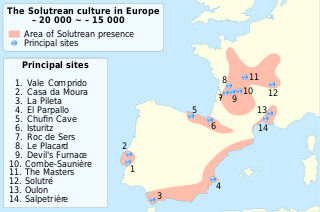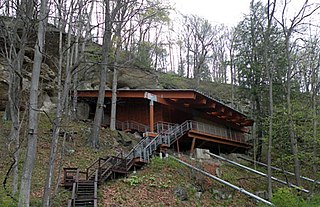Related Research Articles

In the History of Mesoamerica, the stage known as the Paleo-Indian period is the era in the scheme of Mesoamerican chronology which begins with the very first indications of human habitation within the Mesoamerican region, and continues until the general onset of the development of agriculture and other proto-civilisation traits. The conclusion of this stage may be assigned to approximately 9000 BP, and the transition to the succeeding Archaic period is not a well-defined one.

The Solutrean industry is a relatively advanced flint tool-making style of the Upper Paleolithic of the Final Gravettian, from around 22,000 to 17,000 BP. Solutrean sites have been found in modern-day France, Spain and Portugal.

Clovis points are the characteristically fluted projectile points associated with the New World Clovis culture, a prehistoric Paleo-American culture. They are present in dense concentrations across much of North America and they are largely restricted to the north of South America. There are slight differences in points found in the Eastern United States bringing them to sometimes be called "Clovis-like". Clovis points date to the Early Paleoindian period, with all known points dating from roughly 13,400–12,700 years ago. As an example, Clovis remains at the Murry Springs Site date to around 12,900 calendar years ago. Clovis fluted points are named after the city of Clovis, New Mexico, where examples were first found in 1929 by Ridgely Whiteman.

Clovis culture is a prehistoric Paleoamerican archaeological culture, named for distinct stone and bone tools found in close association with Pleistocene fauna, particularly two Columbian mammoths, at Blackwater Locality No. 1 near Clovis, New Mexico, in 1936 and 1937, though Paleoindian artifacts had been found at the site since the 1920s. It existed from roughly 11,500 to 10,800 BCE near the end of the Last Glacial Period.
Topper is an archaeological site located along the Savannah River in Allendale County, South Carolina, United States. It is noted as a location of artifacts which some archaeologists believe to indicate human habitation of the New World earlier than the Clovis culture. The latter were previously believed to be the first people in North America.

The Meadowcroft Rockshelter is an archaeological site which is located near Avella in Jefferson Township, Pennsylvania. The site is a rock shelter in a bluff overlooking Cross Creek, and contains evidence that the area may have been continually inhabited for more than 19,000 years. If accurately dated, it would be one of the earliest known sites with evidence of a human presence and continuous human occupation in the New World.
The Page–Ladson archaeological and paleontological site (8JE591) is a deep sinkhole in the bed of the karstic Aucilla River that has stratified deposits of late Pleistocene and early Holocene animal bones and human artifacts. The site was the first pre-Clovis site discovered in southeastern North America; radiocarbon evidence suggests that the site dates from 14,200 to 14,550 BP. These dates are roughly 1,000 to 1,500 years before the advent of the Clovis culture. Early dates for Page–Ladson challenge theories that humans quickly decimated large game populations in the area once they arrived.

The Solutrean hypothesis on the peopling of the Americas claims that the earliest human migration to the Americas took place from Europe, with Solutreans traveling along pack ice in the Atlantic Ocean. This hypothesis contrasts with the mainstream academic narrative that the Americas were first populated by people crossing the Bering Strait to Alaska by foot on what was land during the Last Glacial Period or by following the Pacific coastline from Asia to America by boat.

Pedra Furada is an important collection of over 800 archaeological sites in the state of Piauí, Brazil. These include hundreds of rock paintings dating from circa 12,000 years before present. More importantly, charcoal from very ancient fires and stone shards that may be interpreted as tools found at the location were dated from 48,000 to 32,000 years before present, suggesting the possibility of a human presence tens of thousand of years prior to the arrival of the Clovis people in North America.

The Paisley Caves or the Paisley Five Mile Point Caves complex is a system of eight caves in an arid, desolate region of south-central Oregon, United States north of the present-day city of Paisley, Oregon. The caves are located in the Summer Lake basin at 4,520 feet (1,380 m) elevation and face west, carved into a ridge of Miocene and Pliocene era basalts mixed with soft volcanic tuffs and breccias by Pleistocene-era waves from Summer Lake. One of the caves may contain archaeological evidence of the oldest definitively-dated human presence in North America. The site was first studied by Luther Cressman in the 1930s.

The Thunderbird Archaeological District, near Limeton, Virginia, is an archaeological district described as consisting of "three sites—Thunderbird Site, the Fifty Site, and the Fifty Bog—which provide a stratified cultural sequence spanning Paleo-Indian cultures through the end of Early Archaic times with scattered evidence of later occupation."

Cueva Fell or Fell'sCave is a natural cave and archaeological site in southern Patagonia. Cueva Fell is in proximity to the Pali Aike Crater, another significant archaeological site. Cueva Fell combined with the nearby Pali Aike site have been submitted to UNESCO as a possible World Heritage Site.
Pendejo Cave is a geological feature and archaeological site located in southern New Mexico about 20 miles east of Orogrande. Archaeologist Richard S. MacNeish claimed that human occupation of the cave pre-dates by tens of thousands of years the Clovis Culture, traditionally believed to be one of the oldest if not the oldest culture in the Americas.
The Buttermilk Creek complex is the remains of a paleolithic settlement along the shores of Buttermilk Creek in present-day Salado, Texas, dated to approximately 15,500 years old. If confirmed, the site represents evidence of human settlement in the Americas that pre-dates the Clovis culture.
Dust Cave is a Paleoindian archaeology site located in northern Alabama. It is in the Highland Rim in the limestone bluffs that overlook Coffee Slough, a tributary of the Tennessee River. The site was occupied during the Pleistocene and early Holocene eras. 1LU496, another name for Dust Cave, was occupied seasonally for 7,000 years. The cave was discovered in 1984 by Dr. Richard Cobb and initially excavated in 1989 under Dr. Boyce Driskell from the University of Alabama.
As is the case with most native populations that did not use systems of writing for most or all of their history, much of what is known about Native Americans comes from the records of the Europeans who first encountered them in the late 16th and early 17th centuries. Some of these accounts are accurate, while some include parts that are accurate and other parts that reflect their biases towards native peoples. One aspect of native life which the European colonists often remarked upon, when they left written records, was their system of agriculture.

The Gault archaeological site is an extensive, multicomponent site located in Florence, Texas, United States on the Williamson-Bell County line along Buttermilk Creek about 250 meters upstream from the Buttermilk Creek complex. It bears evidence of almost continuous human occupation, starting at least 16,000 years ago—making it one of the few archaeological sites in the Americas at which compelling evidence has been found for human occupation dating to before the appearance of the Clovis culture. Archaeological material covers about 16 hectares with a depth of up to 3 meters in places. About 30 incised stones from the Clovis period engraved with geometric patterns were found there as well as others from periods up to the Early Archaic. Incised bone was also found.
Anzick-1 is a Paleo-Indian male infant whose remains were found in south central Montana, United States, in 1968, and date to 13,000–12,850 years BP. The child was found with more than 115 tools made of stone and antlers and dusted with red ocher, suggesting an honorary burial. Anzick-1 is the only human who has been discovered from the Clovis Complex, and is the first ancient Native American genome to be fully sequenced.

The peopling of the Americas began when Paleolithic hunter-gatherers entered North America from the North Asian Mammoth steppe via the Bering land bridge, which had formed between northeastern Siberia and western Alaska due to the lowering of sea level during the Last Glacial Maximum. These populations expanded south of the Laurentide Ice Sheet and spread rapidly southward, occupying both North and South America, by 12,000 to 14,000 years ago. The earliest populations in the Americas, before roughly 10,000 years ago, are known as Paleo-Indians. Indigenous peoples of the Americas have been linked to Siberian populations by linguistic factors, the distribution of blood types, and in genetic composition as reflected by molecular data, such as DNA.
The coastal migration hypothesis is one of two leading hypotheses about the settlement of the Americas at the time of the Last Glacial Maximum. It proposes one or more migration routes involving watercraft, via the Kurile island chain, along the coast of Beringia and the archipelagos off the Alaskan-British Columbian coast, continuing down the coast to Central and South America. The alternative is the hypothesis solely by interior routes, which assumes migration along an ice-free corridor between the Laurentide and Cordilleran ice sheets during the Last Glacial Maximum.
References
- 1 2 Johnson, Michael F. (11 July 2012). "Cactus Hill Archaeological Site". Encyclopedia Virginia. Virginia Foundation for the Humanities. Retrieved 2 January 2014.
- 1 2 "Most scientists now reject the idea that the first Americans came by land". 4 November 2017.
- 1 2 "Stone Age Columbus". Horizon. BBC. 21 November 2002. Retrieved 2 January 2014.
- ↑ Ker Than, "Oldest Burial Yields DNA Evidence of First Americans", National Geographic, 12 February 2014, accessed 20 January 2015
- ↑ Fagundes, Nelson J.R. et al. (2008) "Mitochondrial Population Genomics Supports a Single Pre-Clovis Origin with a Coastal Route for the Peopling of the Americas," The American Journal of Human Genetics 82(March): pp. 1–10, doi : 10.1016/j.ajhg.2007.11.013
- ↑ "Underwater discovery reveals 14,550 year-old Florida mastodon hunters". 13 May 2016.
- ↑ Rose, Michael (April 10, 2000). "Cactus Hill Update". Archaeology.
- ↑ Surovell, Todd A.; Allaun, Sarah A.; et al. (April 20, 2022). Garvey, Raven (ed.). "Late date of human arrival to North America: Continental scale differences in stratigraphic integrity of pre-13,000 BP archaeological sites". PLOS One . 17 (4): e0264092. doi: 10.1371/journal.pone.0264092 . PMC 9020715 . PMID 35442993.
- ↑ Rose, Mark (April 10, 2000). "Cactus Hill Update". Archaeology.com . Archaeological Institute of America . Retrieved May 25, 2023.
Evidence for a pre-Clovis level at Cactus Hill was presented in a series of papers given on April 7 at the annual Society for American Archaeology conference in Philadelphia by the director of the excavations at Cactus Hill, Joseph McAvoy, and a number of specialists studying various aspects of the site. ... Review of the radiocarbon samples by palaeobotanist Lucinda McSweeney ... The stone tool assemblage at the site was described by Larry Kimball.
- ↑ Staff. "A Journey to a New Land: Glacial and Post-Glacial Archaeology of North America (Original 1993 site, revised 2005. Some content outdated.)". Simon Fraser University/Department of Archaeology - Museum of Archaeology & Ethnology. Archived from the original on August 10, 2020. Retrieved May 25, 2023.
- ↑ "Pre-Clovis Occupation on the Nottoway River in Virginia". Athena Review. 2 (3). 2000. Archived from the original on 17 October 2007. Retrieved 2 January 2014.
- ↑ Macphail, Richard; McAvoy, Joseph (August 15, 2008). "A micromorphological analysis of stratigraphic integrity and site formation at Cactus Hill, an Early Paleoindian and hypothesized pre-Clovis occupation in south-central Virginia, USA". Geoarchaeology. 23 (5): 675–694. doi:10.1002/gea.20234. S2CID 130567737.
- ↑ Straus, Lawrence Guy, David J. Meltzer, and Ted Goebel. "Ice Age Atlantis? Exploring the Solutrean-Clovis 'connection'." World Archaeology 37.4 (2005): 507-32. Print.
- ↑ Meltzer, David (2009). First Peoples in the New World. University of California Press. p. 188. ISBN 9780520267992.
